Baixa and the Praças:
Baixa, is considered the lower part of city, starting from the Praça do Comércio through the arch to Rua Augusta, the famous shopping street, right up to the Rossio, where a wide road starts, the Avenida da Liberdade, which in turn ends at the Marques de Pombal Praça.
In 1755, the Baixa was completely destroyed, approximately 23.5 acres, by ‘the’ earthquake. On behalf of the Marquis de Pombal the centre was rebuilt with wide streets and clear squares such as the Praça do Comércio, Praça da Figueira, Praça do Rossio and Praça dos Restauradores. The Baixa is also refered to as the Baixa Pombalina due to the principal Marquês de Pombal, and is on the UNESCO World Heritage List.
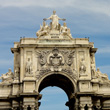 Praça do Comércio:
Praça do Comércio:
Praça do Comercio, also known as the Terreiro do Paço, is one of the largest squares of Lisbon and was once the main maritime entrance to the city. The Terreiro do Paço is a reference to the royal palace, which stood here for 400 years, but has been completely destroyed by the earthquake in 1755. In the middle of the square stands a statue of Dom Jose I, who was the reigning king of Portugal at the time of the earthquake. Note the bronze serpents amongst the feet of the horse, this ensures that no birds will land on the statue.
On the north side of the square stands a triumphal arch, adorned with historical figures such as Vasco da Gama and the Marquis of Pombal. Here starts the Rua Augusta, one of the main shopping streets of Lisbon.
Tip: on the right side (north), Praça do Comércio 37, Lisbon’s oldest cafe can be found, “Martinho da Arcada” from 1782, where once the light came from oil lamps, and have been replaced first by gas lamps and now and electric lights light up the room.
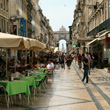 Rua Augusta:
Rua Augusta:
Rua Augusta is the shopping street for pedestrians, where, in addition to numerous shops, you also have some great terraces. Some of the parallel streets around Rua Augusta take their names of the trades that used to be sold here: Rua da Prata – Silver Street, Rua do Ouro – Gold street, Rua dos Sapateiros – Shoemaker Street.
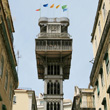 Elevador de Santa Justa:
Elevador de Santa Justa:
In one of the side streets of Rua Augusta, you can see the Elevador de Santa Justa, also known as the Elevador do Carmo, which connects the Baixa with the upper district of Bairro Alto. This neo-Gothic lift first opened in 1902, and was designed by Raoul Mesnier du Ponsard, a pupil of Alexandre Gustave Eiffel. The steam-driven 45 meter high elevator made from cast iron was converted into an electric elevator in 1907.
Tip: besides being able to have drink on top of the elevator, take in the view over the city and the Tagus river.
Link: Elevador de Santa Justa
Address: Rua do Ouro (Baixa)
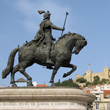 Praça da Figueira:
Praça da Figueira:
In the past, there was a market in the Praça da Figueira in the daytime, and the place where all Lisboners gathered during the festivities of the Santos Populares (the Saints: Santo António, São João e São Pedro) in the 19th century. Today, it has given way to market shops, cafes and hotels. In the middle of the square stands the statue of King Dom João I.
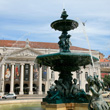 Praça do Rossio:
Praça do Rossio:
On the Rossio, once known as the Dom Pedro IV Square, stands the National Theatre of Dona Maria II, which overlooks a fountain where at the beginning of October the students of the university will be inducted. In the middle of the square stands the statue of Dom Pedro IV, with four female figures scattered around his feet that represent strength, modesty, wisdom and justice. A little further on, between the Praça do Rossio and Praça dos Restauradores is the Rossio train station, built completely in Manuel-style in 1886, and beautifully decorated. Take a look especially at the ceiling, the doors 8 and 9, as well as the decorated windows, and bell tower on the facade. The train platforms were built some 30 meters above the main entrance and are now connected to the subway.
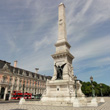 Praça dos Restauradores:
Praça dos Restauradores:
Just past the Rossio train station starts Restauradores Square, that is easily recognizable by the obelisk and statue that commemorate the independence of Portugal from the Spanish in 1640. At the square stands the renovated Hotel Eden Orion, which was once a theatre, with a garden with palm trees above the entrance.
Tip: the Lisbon tourist office (indicated by ‘i’) is found here, next to the hotel, where you can get lots of information, brochures and discounts throughout the city.
 Ascencor da Glória:
Ascencor da Glória:
From the Praça dos Restauradores leaves a cable car, the Elevador da Gloria of 1885, which traveles 265 meters at an incline of 18% between Restauradores Square (Baixa), and Rua de S. Pedro de Alcântara in Bairro Alto. At the top on the right-hand side is the Miradouro de São Pedro de Alcântara viewpoint, where you have a stunning view over the centre and the Castle of São Jorge. The cable car is widely used by locals and runs every day between 7:00 and 0:55 pm.
Tip: do you want to take another ride in a cable car? A little further is the Ascensor do Lavra.
Link: Ascensor da Gloria (EN)
Link: Ascensor do Lavra (EN)
Adres: Praça dos Restauradores (Baixa)


Laat wat achter - Leave a Comment